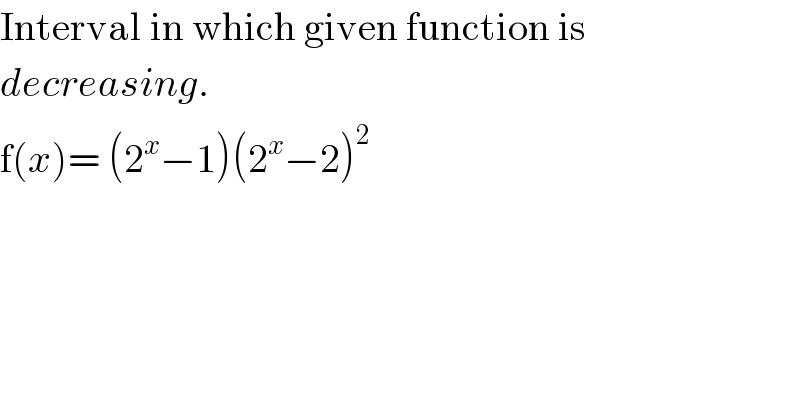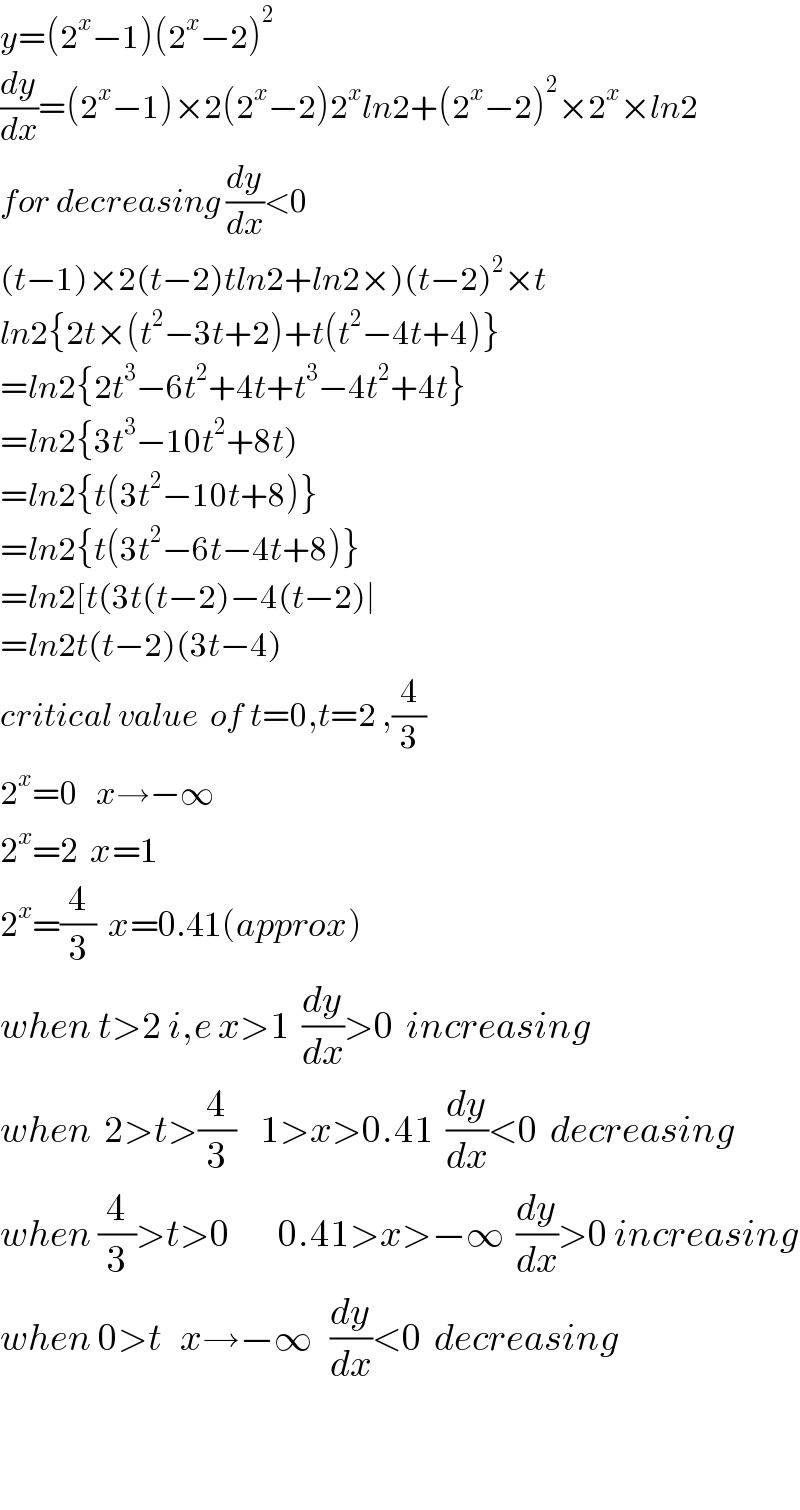
Question Number 36957 by rahul 19 last updated on 07/Jun/18

$$\mathrm{Interval}\:\mathrm{in}\:\mathrm{which}\:\mathrm{given}\:\mathrm{function}\:\mathrm{is} \\ $$$${decreasing}. \\ $$$$\mathrm{f}\left({x}\right)=\:\left(\mathrm{2}^{{x}} −\mathrm{1}\right)\left(\mathrm{2}^{{x}} −\mathrm{2}\right)^{\mathrm{2}} \\ $$
Answered by tanmay.chaudhury50@gmail.com last updated on 07/Jun/18

$${y}=\left(\mathrm{2}^{{x}} −\mathrm{1}\right)\left(\mathrm{2}^{{x}} −\mathrm{2}\right)^{\mathrm{2}} \\ $$$$\frac{{dy}}{{dx}}=\left(\mathrm{2}^{{x}} −\mathrm{1}\right)×\mathrm{2}\left(\mathrm{2}^{{x}} −\mathrm{2}\right)\mathrm{2}^{{x}} {ln}\mathrm{2}+\left(\mathrm{2}^{{x}} −\mathrm{2}\right)^{\mathrm{2}} ×\mathrm{2}^{{x}} ×{ln}\mathrm{2} \\ $$$${for}\:{decreasing}\:\frac{{dy}}{{dx}}<\mathrm{0} \\ $$$$\left.\left({t}−\mathrm{1}\right)×\mathrm{2}\left({t}−\mathrm{2}\right){tln}\mathrm{2}+{ln}\mathrm{2}×\right)\left({t}−\mathrm{2}\right)^{\mathrm{2}} ×{t} \\ $$$${ln}\mathrm{2}\left\{\mathrm{2}{t}×\left({t}^{\mathrm{2}} −\mathrm{3}{t}+\mathrm{2}\right)+{t}\left({t}^{\mathrm{2}} −\mathrm{4}{t}+\mathrm{4}\right)\right\} \\ $$$$={ln}\mathrm{2}\left\{\mathrm{2}{t}^{\mathrm{3}} −\mathrm{6}{t}^{\mathrm{2}} +\mathrm{4}{t}+{t}^{\mathrm{3}} −\mathrm{4}{t}^{\mathrm{2}} +\mathrm{4}{t}\right\} \\ $$$$={ln}\mathrm{2}\left\{\mathrm{3}{t}^{\mathrm{3}} −\mathrm{10}{t}^{\mathrm{2}} +\mathrm{8}{t}\right) \\ $$$$={ln}\mathrm{2}\left\{{t}\left(\mathrm{3}{t}^{\mathrm{2}} −\mathrm{10}{t}+\mathrm{8}\right)\right\} \\ $$$$={ln}\mathrm{2}\left\{{t}\left(\mathrm{3}{t}^{\mathrm{2}} −\mathrm{6}{t}−\mathrm{4}{t}+\mathrm{8}\right)\right\} \\ $$$$={ln}\mathrm{2}\left[{t}\left(\mathrm{3}{t}\left({t}−\mathrm{2}\right)−\mathrm{4}\left({t}−\mathrm{2}\right)\mid\right.\right. \\ $$$$={ln}\mathrm{2}{t}\left({t}−\mathrm{2}\right)\left(\mathrm{3}{t}−\mathrm{4}\right) \\ $$$${critical}\:{value}\:\:{of}\:{t}=\mathrm{0},{t}=\mathrm{2}\:,\frac{\mathrm{4}}{\mathrm{3}} \\ $$$$\mathrm{2}^{{x}} =\mathrm{0}\:\:\:{x}\rightarrow−\infty \\ $$$$\mathrm{2}^{{x}} =\mathrm{2}\:\:{x}=\mathrm{1} \\ $$$$\mathrm{2}^{{x}} =\frac{\mathrm{4}}{\mathrm{3}}\:\:{x}=\mathrm{0}.\mathrm{41}\left({approx}\right) \\ $$$${when}\:{t}>\mathrm{2}\:{i},{e}\:{x}>\mathrm{1}\:\:\frac{{dy}}{{dx}}>\mathrm{0}\:\:{increasing} \\ $$$${when}\:\:\mathrm{2}>{t}>\frac{\mathrm{4}}{\mathrm{3}}\:\:\:\:\mathrm{1}>{x}>\mathrm{0}.\mathrm{41}\:\:\frac{{dy}}{{dx}}<\mathrm{0}\:\:{decreasing} \\ $$$${when}\:\frac{\mathrm{4}}{\mathrm{3}}>{t}>\mathrm{0}\:\:\:\:\:\:\:\:\mathrm{0}.\mathrm{41}>{x}>−\infty\:\:\frac{{dy}}{{dx}}>\mathrm{0}\:{increasing} \\ $$$${when}\:\mathrm{0}>{t}\:\:\:{x}\rightarrow−\infty\:\:\:\frac{{dy}}{{dx}}<\mathrm{0}\:\:{decreasing} \\ $$$$ \\ $$$$ \\ $$
Answered by ajfour last updated on 07/Jun/18
 =(2^x ln 2)(u−2)(3u−4) (dy/dx) ≤ 0 ⇒ (4/3) ≤ 2^x ≤ 2 ((2ln 2−ln 3)/(ln 2)) ≤ x ≤ 1 .](Q36964.png)
$${let}\:\:\:{u}=\mathrm{2}^{{x}} \:\:\Rightarrow\:\:\frac{{du}}{{dx}}=\mathrm{2}^{{x}} \mathrm{ln}\:\mathrm{2} \\ $$$${y}=\left({u}−\mathrm{1}\right)\left({u}−\mathrm{2}\right)^{\mathrm{2}} \\ $$$$\frac{{dy}}{{dx}}=\left[\left({u}−\mathrm{2}\right)^{\mathrm{2}} +\mathrm{2}\left({u}−\mathrm{1}\right)\left({u}−\mathrm{2}\right)\right]\left(\mathrm{2}^{{z}} \mathrm{ln}\:\mathrm{2}\right) \\ $$$$\:\:\:\:\:=\left(\mathrm{2}^{{x}} \mathrm{ln}\:\mathrm{2}\right)\left({u}−\mathrm{2}\right)\left(\mathrm{3}{u}−\mathrm{4}\right) \\ $$$$\frac{{dy}}{{dx}}\:\leqslant\:\mathrm{0}\:\Rightarrow\:\frac{\mathrm{4}}{\mathrm{3}}\:\leqslant\:\mathrm{2}^{{x}} \:\leqslant\:\mathrm{2} \\ $$$$\:\:\frac{\mathrm{2ln}\:\mathrm{2}−\mathrm{ln}\:\mathrm{3}}{\mathrm{ln}\:\mathrm{2}}\:\:\leqslant\:\:{x}\:\:\leqslant\:\:\mathrm{1}\:\:. \\ $$
